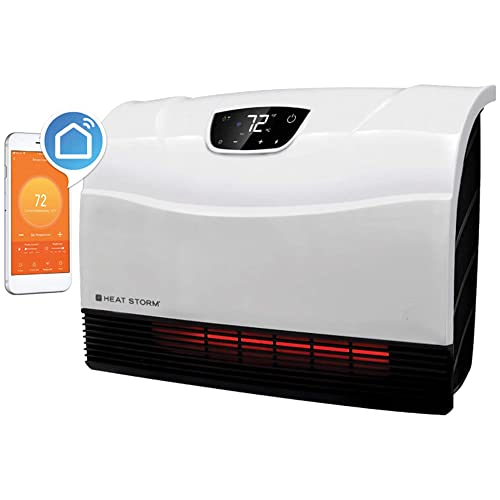Are you tired of shivering through those chilly winter nights? Do you want to ensure that your home is warm and cozy without breaking the bank? Look no further. In this blog post, we will explore the world of radiant heaters, serving as your guide in comparing the different types available. We understand that choosing the right heating solution for your home can be overwhelming. That’s why we are here to bring you clarity and help you make an informed decision. So, sit back, relax, and let us take you through the features and benefits of various radiant heaters, so you can find the perfect fit for your needs.
Top-Rated Radiant Heaters for Efficient and Comfortable Heating
Understanding Radiant Heaters
Radiant heaters are a popular choice for providing efficient and targeted heating in various settings, whether it’s a home, office, or outdoor space. In this blog section, we will delve into the concept of radiant heaters and explore how they work. By the end of this article, you will have a clear understanding of the basic principles behind these devices and why they are an effective heating solution.
How Do Radiant Heaters Work?
Radiant heaters work by emitting infrared radiation, which directly heats objects and people in its path, rather than heating the surrounding air. This method of heating is similar to the way the sun warms the Earth. The heat produced by radiant heaters is absorbed by the objects it reaches, converting it into warmth and providing a comfortable environment.
Direct and Indirect Radiant Heaters
There are two main types of radiant heaters: direct and indirect. Let’s explore the differences between these two types:
Direct Radiant Heaters
Direct radiant heaters emit infrared radiation in a specific direction, providing targeted heat to a particular area. These heaters are ideal for spaces where you want to focus the heat on a specific zone. Some common examples of direct radiant heaters include:
- Infrared Panels: These slim and sleek panels can be mounted on walls or ceilings to provide efficient and discreet heating. They are a great option for heating individual rooms or large spaces.
- Infrared Patio Heaters: Designed for outdoor use, these heaters emit warmth directly to the people and objects within their vicinity, ensuring a cozy experience on cool evenings.
Indirect Radiant Heaters
Indirect radiant heaters, on the other hand, heat up air in a space before distributing it. The warm air then circulates, providing overall warmth to the room. Here are a few examples of indirect radiant heaters:
- Radiant Tube Heaters: These heaters are commonly used in industrial settings, such as warehouses or garages. Benefits of Installing a Garage Heaters. They heat the surrounding air through a tube system, allowing for efficient and even distribution of warmth.
- Radiant Floor Heating: This type of radiant heater is installed beneath the floor and warms the surface, which then radiates heat upwards, offering a comfortable environment.
Benefits of Radiant Heaters
Radiant heaters offer several benefits that make them a compelling heating solution for various applications. Here are some key advantages:
- Efficient Heating: Radiant heaters provide direct heat to individuals or objects, ensuring minimal heat loss. This efficiency can lead to energy savings and lower heating costs.
- Quick Warmth: Unlike traditional heating systems that take time to warm up an entire room, radiant heaters provide instant warmth as soon as they are turned on.
- Zoned Heating: By using direct radiant heaters, you can heat specific areas within a room, allowing occupants to customize their comfort levels and reduce overall energy consumption.
- Safe and Silent Operation: Radiant heaters do not use fans or blowers, making them a silent heating solution. Additionally, they do not circulate allergens or dust particles, making them beneficial for people with respiratory sensitivities.
Types of Radiant Heaters
Radiant heaters are a popular choice for providing efficient and cozy heat in various residential and commercial settings. These heaters work by emitting infrared radiation, which directly warms people and objects in their vicinity. In this blog section, we will delve into the different types of radiant heaters available in the market, highlighting their unique features, advantages, and disadvantages.
Electric Radiant Heaters
Description: Electric radiant heaters are powered by electricity and are known for their ease of use and versatility. They come in various sizes, shapes, and designs, making them suitable for different spaces and applications.
Advantages:
- They are easy to install and require minimal maintenance.
- Electric radiant heaters provide instant heat and allow for precise temperature control.
- They are often compact, making them suitable for smaller spaces.
- Some models come with additional features such as built-in timers and thermostats for added convenience.
Disadvantages:
- Electric radiant heaters may have higher operating costs compared to other types.
- They may take some time to heat up larger areas.
- In case of power outages, they won’t work unless there is a backup power source.
Gas-Fired Radiant Heaters
Description: Gas-fired radiant heaters, also known as gas heaters or gas patio heaters, utilize natural gas or propane as a fuel source. These heaters are commonly used in outdoor spaces like patios, restaurants, and warehouses.
Advantages:
- They provide powerful heat output, making them suitable for heating larger spaces.
- Gas-fired radiant heaters are often more energy-efficient compared to electric heaters.
- Some models feature adjustable heat settings, allowing users to customize the level of warmth.
- They can operate during power outages, unlike electric heaters.
Disadvantages:
- The initial setup of gas-fired radiant heaters requires professional installation.
- These heaters produce combustion gases that need proper ventilation to prevent the buildup of harmful fumes.
- Gas heaters may not be suitable for enclosed spaces due to ventilation requirements.
Infrared Radiant Heaters
Description: Infrared radiant heaters utilize electromagnetic radiation to produce heat. These heaters can be found in various forms, including wall-mounted panels and overhead heaters.
Advantages:
- Infrared radiant heaters directly heat objects and people, rather than the surrounding air, resulting in more efficient and targeted heating.
- They provide quick and focused heat, making them ideal for outdoor areas and spaces with high ceilings.
- Infrared heaters are often durable and long-lasting, requiring minimal maintenance.
- Some models come with advanced features such as remote control operation and programmable timers.
Disadvantages:
- The initial cost of purchasing and installing infrared radiant heaters can be higher compared to other types.
- They may require professional installation for optimum performance.
- Infrared heaters do not provide instant heat like electric heaters, requiring a warm-up period.
Factors to Consider
Choosing the right radiant heater for your space can seem like a daunting task with so many options available in the market. To help you make an informed decision, we have compiled a list of key factors that you should consider before purchasing a radiant heater. By understanding these factors, you will be able to find a heater that meets your specific heating needs efficiently and effectively.
1. Size
The size of the radiant heater is an important consideration as it will determine the heating capacity and coverage area. A heater that is too small might not provide sufficient heat, while one that is too large can lead to energy wastage. To determine the ideal size, consider the dimensions of the space you need to heat and choose a radiant heater that can effectively cover that area.
2. Heating Capacity
Radiant heaters come in various heating capacities, measured in British Thermal Units (BTUs) or watts. Understanding the heating capacity of a heater is crucial to ensure that it will be able to generate enough heat for your space. Consider factors such as room size, ceiling height, insulation, and climate to determine the appropriate heating capacity for your needs.
3. Energy Efficiency
Energy efficiency is a key consideration for anyone looking to reduce their energy consumption and lower their heating costs. Look for radiant heaters that have Energy Star certification or high Energy Efficiency Ratio (EER) ratings. These heaters are designed to operate efficiently, saving you money on energy bills without compromising on performance.
4. Installation Requirements
Consider the installation requirements of the radiant heater you are considering. Some models may require professional installation, while others can be easily set up by homeowners. Take into account factors such as power source availability, mounting options, and ventilation requirements to ensure a hassle-free installation process.
5. Safety Features
Safety is of utmost importance when choosing a radiant heater. Look for heaters that have built-in safety features such as tip-over protection, overheating protection, and child lock features. These features can help prevent accidents and provide peace of mind, especially in households with children or pets.
Comparing Radiant Heaters
When it comes to choosing the right radiant heaters for your heating needs, it’s important to have a clear understanding of the different types available in the market. In this section, we will provide a detailed comparison of the various radiant heaters discussed earlier, including their performance, cost-effectiveness, maintenance requirements, and additional features. This comprehensive analysis will help you make an informed decision that suits your specific requirements.
1. Panel Heaters
Performance:
- Uniform heat distribution across the room, ensuring comfortable warmth throughout.
- Quick heat-up time, providing instant warmth when turned on.
- Adjustable thermostat for precise temperature control.
- Some models equipped with a programmable timer for added convenience.
Cost-effectiveness:
- Energy-efficient technology helps reduce heating costs.
- Ability to heat individual rooms allows for better control of energy usage.
- Low purchase and installation costs compared to other radiant heaters.
Maintenance:
- Simple to clean and maintain.
- Dust and dirt accumulation can affect performance, so periodic cleaning is recommended.
Additional Features:
- Some models offer Wi-Fi connectivity for remote control through smartphone apps.
- Overheat protection and child lock features for enhanced safety.
2. Infrared Heaters
Performance:
- Rapid heat transfer, providing warmth directly to objects and individuals within the room.
- Silent operation, making them ideal for bedrooms, offices, and other quiet environments.
- Adjustable heat output for customized comfort.
- Some models offer oscillation feature for wider heat coverage.
Cost-effectiveness:
- Energy-efficient technology minimizes electricity consumption.
- Focused heating reduces energy wastage by eliminating the need to heat the entire room.
Maintenance:
- Generally low maintenance with no filters or fans to clean.
- May require occasional bulb replacement.
Additional Features:
- Convenient remote control for easy adjustments.
- Models equipped with built-in thermostat and timer functions.
3. Electric Radiant Floor Heating
Performance:
- Provides consistent and even heat across the entire floor, ensuring comfortable warmth.
- Suitable for large areas such as living rooms, kitchens, and bathrooms.
- Compatible with various types of floor coverings, including tiles, hardwood, and laminate.
Cost-effectiveness:
- Energy-efficient technology helps reduce heating costs.
- Ability to zone the heating system allows for targeted heating in specific areas, optimizing energy usage.
- Long lifespan, reducing the need for frequent replacement.
Maintenance:
- No special maintenance required once installed.
- Inspect and repair damaged cables or mats when necessary.
Additional Features:
- Compatibility with programmable thermostats for temperature control.
- Wireless sensors for enhanced efficiency and room-specific temperature adjustments.
Key Takeaways and Final Thoughts on Radiant Heaters
In conclusion, this blog post has offered a thorough comparison of various types of radiant heaters. By taking into account key factors such as heating capacity, energy efficiency, and safety features, readers are now equipped to make an informed decision based on their specific requirements. Following our analysis, we suggest individuals prioritize energy efficiency and safety as top considerations when selecting a radiant heater.
Frequently Asked Questions about Radiant Heaters
What are the important factors to consider when choosing a radiant heater, such as size, heating capacity, and installation requirements?
When choosing a radiant heater, there are several important factors to consider. These include size, heating capacity, and installation requirements.
Size: The size of the radiant heater is an important consideration as it needs to fit well within the space you intend to heat. Measure the area to be heated and ensure that the dimensions of the heater are suitable for the space available. Additionally, consider the height of the heater, as this can affect its efficiency and effectiveness in distributing heat evenly.
Heating Capacity: The heating capacity of a radiant heater is a crucial factor in determining its suitability for your needs. It is typically measured in British Thermal Units (BTUs) and represents the amount of energy the heater can produce. Calculate the required heating capacity based on the size of the room, insulation quality, and desired temperature rise. Ensure the radiant heater can deliver the necessary BTUs to efficiently and effectively heat the space.
Installation Requirements: Understanding the installation requirements of a radiant heater is essential to ensure a smooth and safe installation. Consider the electrical requirements, such as voltage and power supply availability, to ensure compatibility with your electrical system. Additionally, evaluate the mounting options, such as wall-mounted, ceiling-mounted, or freestanding, and choose one that suits your needs and the available space. Some radiant heaters may require professional installation, so consider this factor if you prefer a hassle-free setup.
In addition to size, heating capacity, and installation requirements, it is also advisable to consider factors such as energy efficiency, safety features, thermostat controls, durability, and warranty. By carefully evaluating these factors, you can make an informed decision and choose a radiant heater that meets your heating needs effectively.
Retailers and Online Stores for Radiant Heaters
As the chill of winter begins to bite, the quest for the most efficient and comfortable heating solution brings many to the warm embrace of radiant heaters. Unlike traditional heating systems that simply heat the air, radiant heaters transfer warmth directly to objects and people, providing a cozy atmosphere without the wait. This technology comes in various types, each with specific applications, benefits, and design features suited for different needs and preferences.
In this exploration, we delve into the world of radiant heaters, starting with the different types available on the market— from electric to hydronic, from panels designed to adorn walls to portable units that can move where you do. We’ll discuss their applications, highlighting how they can be used in residential settings, outdoor spaces, and even commercial environments, ensuring you remain toasty where it matters most.
Moreover, we’ll outline the benefits that make radiant heaters a compelling choice for consumers, such as energy efficiency, improved indoor air quality, and the gentle, consistent warmth they’re known for. Lastly, we’ll touch upon the design aspects, which have evolved from purely functional to sleek, modern aesthetics that complement the décor of any space.
Whether you’re outfitting a new home, upgrading your current heating system, or simply looking to stay warm on your patio, understanding the intricacies of radiant heaters could be the key to enduring the winter months with comfort and ease.

























